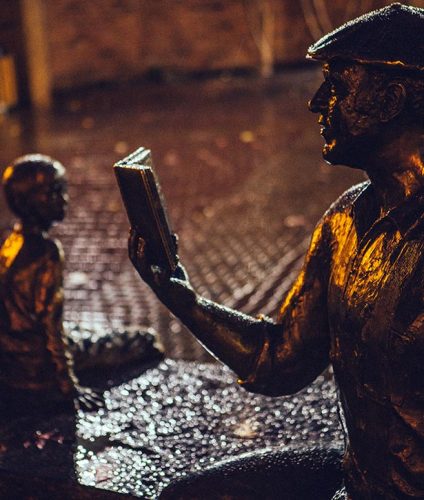
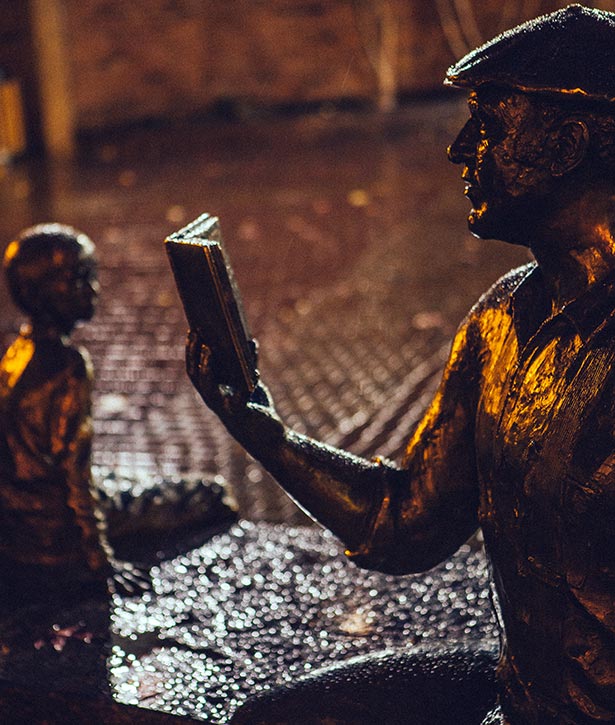 |
| Photo by Todd Cooper. |
Kesey Square is the last public space in Eugene that has no curfew.
As a citizen — not as a consumer or a business owner — if there is one thing to take away from this story, or any story you hear about Kesey Square, regardless of where you fall on the issue, it should be this:
Kesey Square is the last and only place in downtown Eugene, day or night, where you can go to exercise your rights as a citizen, be it freedom of speech or the right to assembly, or just the right to be in the heart of the city.
It is the last place in Eugene, 24-hours a day, seven days a week, where citizens can be without the expectation of spending money or abiding by the rules of a particular business or property owner.
Not even in the spot that has been designated for free speech, the Wayne Morse Free Speech Plaza (i.e. the Saturday Market drum circle spot), can you express your opinions past 11 pm. The county deemed it free speech with a curfew (11 pm to 6 am) in 2013. Free Speech Lite.
As citizens we must ask ourselves: Are public spaces like this still important? It’s a valid question in a time when the internet has caused the public sphere to perpetually fragment and the communities around traditional institutions, like unions and churches, dwindle.
Perhaps, then, the more appropriate question is: Do cities still need places where citizens can be citizens, and not consumers?
The answer is yes for Amanda Burden — the city planner behind New York City’s High Line greenway, one of the most successful and beloved public-space projects of the 21st century.
“If there’s one lesson I’ve learned in my life as a city planner, it is that public spaces have power,” she says in a 2014 TED talk. “Public spaces always need vigilant champions, not only to claim them at the outset for public use, but to design them for the people that use them. Then to maintain them, to make sure they are for everyone, that they are not violated, invaded, abandoned or ignored.”
At the literal crossroads of our city, Kesey Square lies largely unchanged since its creation more than four decades ago when a building was removed from the site. Now, the 55-foot-by-80-foot brick pocket holds all our anxieties about poverty, development, the economy, government, accountability and apathy.
This story is not about the “travelers”* — it’s about neglected public space. This scrappy plaza has become the restless symbol of what happens when you do nothing.
In October, Kesey Square was thrust into the spotlight once again when a group of local business owners, architects and developers proposed to buy it and develop in its place a six-story apartment building with retail space on the ground floor.
For many, the proposal seemed to come out of thin air, prompting a collective: Wait a moment — Kesey Square is for sale?
For others, a proposal to build there was a relief: Kesey Square is a failure; we need to do something.
While another business owner, Ali Emami, says he’s been trying to work with the city for decades to improve Kesey Square. But outside of MUPTE (Multi-Unit Property Tax Exemption) projects, the city has made no funds available to improve Kesey Square.
So why is a public square in the heart of downtown so problematic? How did it get that way? It’s a classic civic tale of lack of vision and action, money and conflicting interests.
A History of Apathy
Through this most recent recession, the city of Eugene has spurred development downtown with financial tools like MUPTE, urban renewal funds and a patchwork of grants and loans.The scattering of city offices around the city, instead of being housed by one city hall, has also provided guarantee rent in new developments like the Woolworth building. And downtown has blossomed, from the construction of the beautiful public library and the new Lane Community College building to the bustling Broadway Commerce Center and the Bijou Metro and all the new restaurants, bars, cafes and shops sprinkled up and down Willamette and Broadway.
To be sure, there have been hiccups along the way — Capstone’s 13th and Olive, the demolition of City Hall and now the closing of the Jacobs Gallery at the Hult Center, to name a few. And the lingering vacant storefronts downtown are a reminder of how fragile the economic recovery has been for this city.
 |
| Nest store Owner Tina Scott |
Downtown is the most vibrant it’s been since before the city opened the pedestrian mall in 1971, making it a car-free zone and, in effect, a dead zone — a move that downtown is still recovering from.
Although the city has addressed many issues with MUPTE — no more student housing, increased regulation — some feel the city hasn’t learned from past mistakes, ignoring the concerns of citizens. Take the most recent MUPTE project, for example: Capstone’s 13th and Olive student housing development, or “Crapstone” as the kids call it these days.
Business owner Tina Scott calls it a monstrosity.
“Week by week, we were suffering,” says Scott, co-owner of Nest, an antique and home furnishing store she runs with her daughter Amy Clancy. Nest was part of the popular “Vintage Row,” the strip of stores across from where 13th and Olive now stands. They have all since relocated or closed.
Scott says their clientele plummeted during its construction, while roads were closed or blocked intermittently for two years.
“Slowly but surely the whole entire area died,” says Scott, adding that her complaints to the city went unanswered for long stretches.
Nest has since relocated, with some help from the city, to a storefront at 8th and Willamette, just north of Kesey Square. “When you move, you lose clientele,” Scott says.
Co-owner and daughter Clancy agrees about the Capstone project: “Our previous business was completely destroyed because of poor choices in city planning.”
Clancy says she likes the current proposal to put apartments in Kesey Square.
“I’ve seen businesses come and go because of Kesey [Square],” she says. “I don’t think there are a ton of options. I’m totally in support of more city housing.”
Scott does not want to see a building go up.
“The same thing is going to happen,” Scott says. “We are the most wasteful society.”
“There’s no organization in the city at all, there’s no history,” she continues. The city is “sporadic, and they’re not really focusing on what makes downtown.”
An Indecent Proposal
This fall, City Manager Jon Ruiz brought to the City Council a proposal to purchase Kesey Square, and eventually use financial aid from the city via MUPTE to build a six-story apartment building, with some workforce housing and retail space on the ground level.
On Oct. 12, Eugene City Council held an executive session on the proposal to purchase city property.
The local team that submitted the proposal to Ruiz includes architects John Rowell and Greg Brokaw, downtown business owner Kazem Oveissi, developer consultant Mark Miksis and advising developers Hugh Prichard and Harris Hoffman.
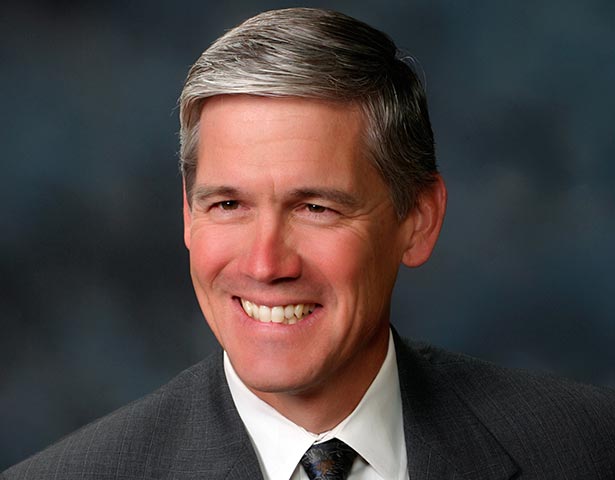 |
| City Manager Jon Ruiz |
Councilor Clair Syrett says she was invited to the office of Rowell Brokaw Architecture some months ago with some of the other councilors, the mayor and Downtown Eugene, Inc. President Sarah Bennett to see “their vision for residential and commercial development.”
Ruiz tells Eugene Weekly that he first became aware of the proposal earlier this year.
“The proposers came to us and had this plan, so we spent time with the city in executive session talking about it,” Ruiz says. “Any time someone offers to purchase property, we would talk about that with council in executive session.”
Ruiz explains, however, that nothing has been decided and, ultimately, it’s up to the City Council to decide whether Kesey Square is indeed for sale.
Typically, for a proposed project of this scope and cultural importance, best practices calls for a city to publicly issue an RFP (request for proposals) for a public space like Kesey Square, if the city is, in fact, accepting proposals for it.
But, as Ruiz and Mayor Kitty Piercy explain, the city has no development plan for the site, so an RFP would be “premature.”
“An RFP actually would indicate that we’ve made up our minds to do something different with that space in terms of a building or something, and we haven’t,” Piercy says.
This lack of a plan coupled with inaction — a common complaint about the city of Eugene — has riled citizens on both sides of the Kesey Square debate.
After protests in the community arose about the unsolicited proposal to purchase Kesey, Ruiz announced that the city is open to other ideas for the site.
“Our intent is not to do an RFP,” Ruiz says. “What we told the council, or mentioned to the council, is that we will invite others who have ideas, to submit those ideas to us.”
Rumors swirled that this proposal got in front of the eyes of the City Council so fast because of favoritism between the city and developers. As stated in The
Register-Guard, Hugh Prichard, one of the advising developers on this proposal, is a friend of Ruiz’s.
Ruiz confirmed that Prichard is indeed a friend, but denied any sort of backroom deals.
“Hugh is a friend and if he’s advising a project, he’s advising a project,” Ruiz says. “That relationship has no bearing whatsoever on this project being considered or not being considered.”
He continues: “If somebody else had come in with a proposal, we would be talking about that proposal.”
Which brings us to the strange case of Ali Emami, a key player in making the square, if it remains a square, a success.
If These Walls Could Talk
The city, local architects and even the Rowell Brokaw Architecture proposal have identified the two blank brick walls at Kesey Square as the major structural issue blocking the square from success. It’s city planning 101: successful squares have permeable boundaries with traffic coming from multiple directions. As the walls now stand, they create a dead zone.
Or as Jerry Diethelm, UO professor emiritus of landscape architecture, wrote in EW in 2013: “It’s the blank brick walls of the adjoining buildings that make up the square’s two dead sides that are holding it back. In any other square in any other city in the world, those sides would be alive with penetrations and connections between the square’s outdoor spaces and the activities and services beyond.”
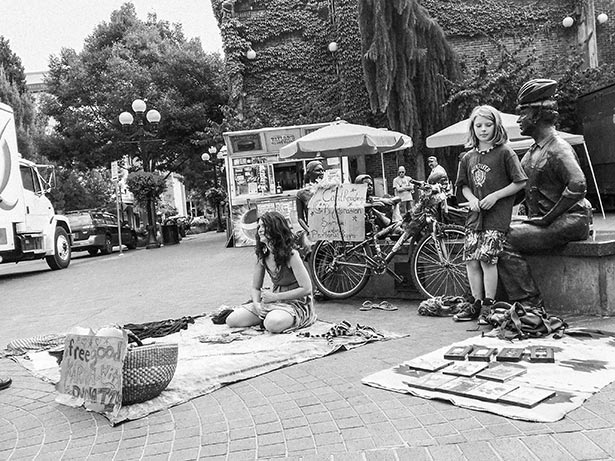 |
| Days of yore in Kesey Square. Photo by Trask Bedortha. |
As EW wrote Nov. 5 (“One Flew Over Kesey Square: Business owner’s plan calls for incubators and public space downtown, not apartments”), Emami had submitted proposals for Kesey Square in 1995 and 2004. After hearing of the proposal to purchase the square, Emami went to the city on Oct. 12, 2015, with a letter reminding the council of his past proposals.
Emami, a downtown business owner and UO senior instructor of finance, owns the building that houses Northwest Persian Rugs (his business) and Voodoo Doughnut. The walls of these businesses make up the two Kesey Square walls. While Emami owns the building, the city owns the square’s walls.
Emami’s plans, starting back in 1995, suggested that he would work with the city to begin punching through the walls with windows and doors to help encourage traffic through the square. Emami was leery of taking any action without the city because the walls have a revocable permit, i.e. the city could ask that any changes made to the walls be reversed.
After the Nov. 5 EW story came out about Emami’s past effort to work with the city to improve the square, Emami says that Nan Laurence, a senior city planner, and Denny Braud, the city’s community development manager, requested a meeting.
“They said at the moment they don’t have any preferences really,” Emami says of the Nov. 9 meeting. “They wanted more information from me, more detailed information.”
Emami says it’s a bit of a chicken-and-egg situation. He wants to know what resources the city can help him with before he invests in a full proposal.
“My details depend on the constraints of the city,” he says. “They cannot promise anything, except maybe, if it is approved, then there might be chances for helping with loans.”
No grants or Urban Renewal funds are currently available for improving Kesey Square. And Emami’s proposal, because it does not include housing, is not eligible for MUPTE. Although he says he told Laurence and Braud that he would be open to the idea of adding housing on top of his properties to align with the city’s goals of increased urban density.
“My point really is, tell me what you want,” Emami says. “Do you want apartments downtown? If that’s the case, we shouldn’t sell the public spaces for apartments. We can put them on top of here.” He points to the roofs of Northwest Persian Rugs and Voodoo Doughnut and pulls out his phone to show pictures of the courtyard rooms with balconies at the Inn at 5th Street Market. The apartments, with balconies, could look down on the square, he says.
Walled In
The city is not required to accept every proposal that lands at its doorstep, but it remains unclear why the city never engaged with Emami’s proposals, which seemed to address all the problems the city has identified as keeping the square from success.
There has been some skepticism to Emami’s commitment to the space.
“I do think some folks in the community might just be a bit skeptical about whether or not his proposal — if it was decided by the community and city to be the best option for Kesey Square — would actually come to fruition,” writes Thomas Pettus-Czar, co-owner of The Barn Light, in an email to EW. The Barn Light is across the street from Emami’s Northwest Persian Rugs store.
“Looking at his property next to Kesey Square,” Pettus-Czar continues, “after seeing ‘For Sale’ and ‘For Lease’ signs go up and come down, go up and come down, it seems strange that nothing has panned out, given the prime location of his building, which is undoubtedly being underutilized.”
“What we realized is that he does have an idea for the plaza,” Laurence says of meeting with Emami. “What wasn’t clear was why he hasn’t implemented his idea.”
To this, Emami responded in an Nov. 16 email to EW: “Punching through a wall without the permission of city is illegal. To punch through a wall in a manner that is attractive would have cost over $100,000 at that time.”
He continues: “No one with any financial sense would make such an investment and then have it removed in a few years. Furthermore, if you want to lease a space to a tenant, you cannot make significant investment and then do a built out and tell your tenant, ‘By the way, you may lose your storefront.’”
“I think he didn’t feel the sense of urgency or maybe he was waiting for the city to help, because we’ve had this conversation with him before,” says senior planner Laurence. “But what it told me was, there are likely other ideas out there as well.”
City Councilor Claire Syrett says she wasn’t aware of Emami’s proposal until October. Councilor Chris Pyror wrote in a Nov. 14 email to EW that he was not aware of his proposal until a week before. “If the last time he proposed it was 2004, that predates nearly all council, the mayor, the city manager and senior executives.”
The last time Emami submitted the proposal was last month — Oct. 26.
As for Emami’s proposal, Mayor Kitty Piercy says she was told that “the city had been interested in opening up those walls and the owner had never been willing to do that.”
She continues: “I was told people had really tried to convince him to do that, but he wasn’t willing to. But I don’t know, because when I look at his current plan, what’s missing is I don’t see any finances.”
No Money for Kesey
In the swirl of downtown development, the city has earmarked no money for renovations or improvements to Kesey Square. Any changes proposed to improve Kesey Square are not eligible for MUPTE unless they include adding housing to the public space.
Emami wonders why Urban Renewal funds for the Downtown Urban Renewal District — an area made up of 15-plus blocks surrounding the square — are not available.
“Prior to [2010], we could have used Urban Renewal money,” Laurence says. “But there wasn’t enough activity downtown. The buildings across the street were vacant. Our idea was to work so closely with the property owners to fill the pits.”
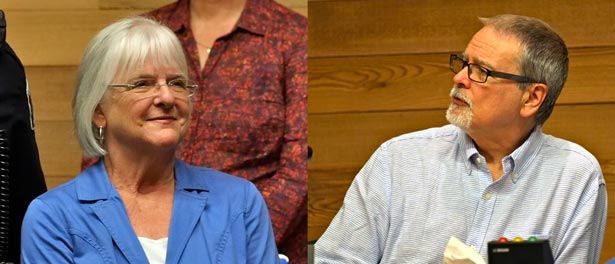 |
| Mayor Kitty Piercy and Councilor Chris Pryor |
In 2010, the City Council amended the downtown Urban Renewal Plan, increasing the spending limit from $13.6 million to $46.6 million and limiting the financing to three main projects: Lane Community’s College’s downtown campus, Broadway Place garages and public safety improvements, and Park Blocks improvements for the Farmers Market. There were also some tag-ons for completing the Broadway Commerce Center and Woolworth Building and adding some lighting downtown.
“Council took action a number of years ago to limit what we could use with downtown Urban Renewal money,” Laurence says. “There was not Urban Renewal money allocated for Kesey [Square].”
Laurence adds: The council “could open up the Urban Renewal Plan and direct us to implement those projects, but right now, we are not authorized to spend that.”
Councilor Pryor says he suspects the square would qualify for Urban Renewal funding. “Right now, our urban renewal capacity is mostly consumed by paying down debt and providing increased policing downtown,” he writes. “I don’t know if there is additional capacity to pay for other projects. The [Downtown Urban Renewal] district is set to expire in 2017, but it’s an intriguing idea.”
Later in an email Piercy forwarded to EW, Laurence writes: “While the district has cash available, no other projects are eligible for funding. Additionally, the Downtown District is set to terminate in the near future.”
Laurence says any money that has been invested in Kesey Square came from LRCS, or Library, Recreation and Cultural Services, for programming events like dodgeball tournaments, fashion shows, movie nights and the plein air paint out series.
“Bottom line, we didn’t have money for physical improvements,” Laurence says. “So we used money that we had for programming.”
This may leave some scratching their heads, as in 2013, the city spent $20,000 to remove a low wall, or bench, facing the square, which many saw as an attempt to remove places where “travelers” could hang out.
Piercy says no council member has ever called a work session on how to improve Kesey Square, beyond looking at proposals for curfews on the public space and increasing the police presence.
“It’s not that they don’t care but it has not reached a level of concern that any of them had a plan or a thought or an initiative,” Piercy says.
Syrett confirms this. “No one on City Council has demanded a work session on it,” Syrett says.
Apathy Made Visible
Why is a public square in the heart of downtown, at the axis of two bustling thoroughfares and surrounded by new development, this problematic? Why don’t more people of all walks of life want to spend time there?
“I’m a proponent of public space both in the urban setting and in the natural setting,” City Manager Ruiz says. “It’s whether or not different spaces are maximized for their use for wherever they happen to be.”
He adds, “For Kesey Plaza, it’s a remnant piece of property from an old project that if you were actually designing an urban place now, you would never design that kind of a space into the geographic heart of your community or civic heart of your community. You just wouldn’t design that space there.”
Syrett agrees about the location. “I guess I don’t get this idea that Kesey is sacred public space, because it’s a remnant from when they closed downtown to cars,” she tells EW. “It’s truly just a piece a property. I personally don’t attach any significance to that corner of downtown.”
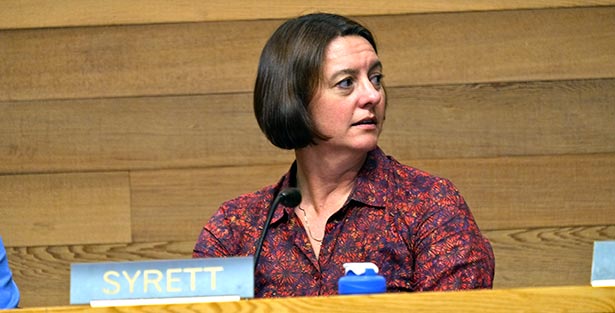 |
| Councilor Claire Syrett |
Pryor says he wants to focus on the Park Blocks. “You commit to improvement of the Park Blocks in a way that makes them useful, vibrant community space,” Pryor says. “And at the end of the day you may have something on Kesey Square that has a gathering element to it, but that wouldn’t be its primary function, but you wouldn’t lose anything.”
Pryor also says the Park Blocks will require a hefty investment of time and money before coming to fruition.
Councilors Betty Taylor and George Brown told EW in the Nov. 5 story they did not support selling the square and putting a building there. The remaining councilors — George Evans, Alan Zelenka, George Poling, Mike Clark — did not respond to requests for comment for this story.
In EW’s discussions with the city manager, the mayor, councilors Syrett and Pryor and City Planner Laurence, they all mentioned that the square was too small, not facing the right cardinal direction and awkward because of the blank walls. They also said that the Park Blocks, and the future plaza at the yet-to-be constructed City Hall, were better designed to function as a public space.
Business owner Kazem Oveissi, one of people behind the proposal to put a building on Kesey Square, echoed these sentiments exactly
“The city has done what they could with the space,” says Oveissi, whose office overlooks the square. “People don’t like to be in that corner.” Oveissi says that, should his proposal be accepted, he hopes to build a ground floor with retail spaces that are “really vibrant and happening.”
“When you look at [Kesey Square], it’s like, ‘this should work,’” Oveissi says. But, he adds, “Kesey Square does not solve our public-space problem.”
Barn Light co-owner Thomas Pettus-Czar is a proponent of Oveissi’s proposal.“It wasn’t designed as a public space,” Pettus-Czar says of Kesey. “The way it’s laid out, the fact that there are two inactive walls, it faces north — those all, to me, support the idea that a building probably makes the most sense on that specific site.”
Many city planners and architectural scholars see it differently. As UO professor of architecture and urban designer James Tice weighed in earlier this year in an EW story (“Sometimes a Great Plaza: The quest to turn Kesey Square into a vibrant public space,” 5/15): “Whether people know it or not, the placement of Kesey Square is highly appropriate, and it’s an echo of that impulse to mark those two important streets.”
The impulse Tice was referring to is marking the intersection of the cardo and decumanus, or a city’s two major streets, a tradition that dates back to ancient Rome.
And whether the city originally intended for Kesey Square to be a public square, it has, after four decades, been adopted as one by the community.
With the expected increase in downtown’s population, “conceiving of the square as actively including the two buildings that create it is the necessary conceptual transformation,” UO professor emeritus Deithelm wrote in EW in April (“Playing Offense at Kesey Square”). “The expanded square idea opens up the possibility of turning an underperforming public open space into a potentially successful public-private partnership and civic asset.”
But we may find the seeds of an answer to the Kesey Square conundrum in another TED talk by author and social critic James Howard Kunstler (Clusterfuck Nation).
“Public spaces should be inspired centers of civic life and the physical manifestation of the common good,” he says, flicking through slides of dilapidated and forgotten public spaces, many of which don’t look so different from Kesey Square. “These are places not worth caring about.”
“We can’t over estimate the amount of despair that we are generating with places like this,” Kunstler continues. “Mostly I want to persuade you that we have to do better.”
The Common Good
If public spaces are physical manifestation of the common good, then Kesey Square is telling us something: no one is trying. Can we really say we have tried to make Kesey Square a meaningful place where people feel free, welcome and actually want to spend their time?
Most days and nights, the city square sits empty. There are currently two food carts, but hours of operation are spotty and the carts are often shuttered. No tables, umbrellas or seating remain. The lighting is dim. Not even the “travelers” hang out there much anymore, seeming rather to prefer the four corners of the “Barmuda Triangle,” at the intersection of Olive and Broadway.
It’s depressing and, to be frank, embarrassing.
When the square is programmed with events, it comes alive. Students, families and Eugeneans of all stripes sat packed like sardines for a 2014 screening of King Kong at the square. Several times, crowds swarm the space for dodge ball games. Just this past Halloween, a flash mob performed Michael Jackson’s “Thriller” in the square to the cheers of patrons sitting outside at The Barn Light and Sizzle Pie. When the space is activated, it thrives.
But programming is mostly confined to the summer months and doesn’t provide a durable good. When the event ends and the programming money is spent, there is no durable good left over — like, a place for people to sit.
Many experts on the subject say that a good public space doesn’t need programming. As professor Tice told EW back in May: “One doesn’t have to program a successful square. A successful square has a life of its own. It’s a part of the community — not a private affair, not one individual corporation owns it. It’s owned by the people of the city, free and open to everyone.”
A successful public space doesn’t happen by accident. Let’s examine the city’s efforts to improve Kesey Square:
Nan Laurence says the city has made electrical upgrades to the square for food carts, installed public art such as Peter Helzer’s Ken Kesey memorial “The Storyteller” (2003) and the Betsey Wolfston “Four Seasons” sculptures (1997), and put in some lighting.
The city manager says they’ve hung and maintained flower baskets as well as worked with the Saturday Market to bring in a couple food carts.
At its peak, Kesey Square had four food carts and a few tables and chairs. At one point, there were umbrellas. Councilor Brown tells EW that the police removed the tables and chairs without permission; Councilor Taylor called for them to be returned, but no action was taken. The city partnered with Saturday Market for the food cart program, which has struggled with vandalism and attacks.
“But that’s as far as we’ve gone,” Laurence says. “We’ve been mostly relying on programming and the food carts to activate the space,” adding that “we programmed it, but we didn’t really have resources to manage it.”
This brings up another question. Is Kesey Square a public safety issue? Many city officials recounted that several of the food cart operators were harassed or attacked while operating the square even though money is allotted for increased public security downtown through Urban Renewal funds.
Jane Jacobs, author of The Death and Life of Great American Cities, the tome used in college city-planning courses around the country, had an idea about safe places:
“This is something everybody already knows: A well-used city street is apt to be a safe street.”
Jacobs introduced this idea of “eyes on the street” as the most effective form of implementing public safety. In other words, the natural surveillance that happens in a busy community, where people look out for one another, from shop owners to “travelers,” helps increase security. A safe public space is a busy public space and vice versa.
Meet Me at the Crossroads
Towards the end of her TED talk, city planner Amanda Burden discusses the challenge of making New York’s High Line greenery.
“The High Line, even though it’s widely known now and phenomononly popular, it is the most contested
public space in the city,” she says. “It’s true: Commercial interests will always battle against public space.”
“The city has to take the long view, a view for the common good,” she continues. “Public space can change how you live in a city, how you feel about a city, whether you choose one city over another. And public space is one of the most important reasons you stay in a city. I believe that a successful city is like a fabulous party: People stay because they’re having a great time.”
While meeting with councilors Syrett, Pryor and Brown, City Manager Ruiz, Mayor Piercy and City Planner Laurence, EW asked if the city had ever considered trying something fairly simple and low-risk with the square, something lively public squares, large and small, do in cities, large and small, around the world: Line the walls with food carts, build a small stage or bandstand in the back corner and fill the remaining space with colorful chairs, tables, umbrellas and perhaps some space heaters. In other words, what if we try to make this a place worth caring about?
Piercy nodded her head, and recalled another simple idea she liked from a Mayor’s Innovation conference where a speaker discussed a small, problematic park that the city decided to fill with 100 movable red chairs.
“When they put the red chairs in, people began to use them in interesting and innovative ways, from music to games to all kinds of stuff,” Piercy says.
In the past few years, several blows have hit at our civic pride. Eugene Celebration is no more. Civic Stadium burned to the ground. The party keeps getting smaller and smaller.
So, anyone want to meet for a dance party at Kesey Square?
On Nov. 17, the city announced it will host a public “Downtown Solutions Forum” 6:30 to 8:30 pm Wednesday, Dec. 2, at LCC’s downtown campus. RSVP to 682-5049 or EugeneDowntown@ci.eugene.or.us.